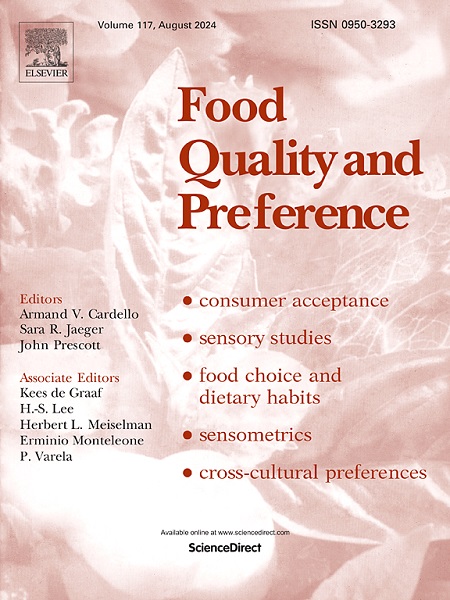When the music stops: Crossmodal effects of sounds on taste do not explain changes in liking
IF 4.9
1区 农林科学
Q1 FOOD SCIENCE & TECHNOLOGY
引用次数: 0
Abstract
Environmental sounds influence taste perception and liking of food because eating is a multisensory experience that integrates all senses. The present study investigated how a dark chocolate ganache with two different levels of added sugar was perceived when sounds corresponding to sweet and bitter tastes were played, as well as no sound. A total of 515 participants rated the balance of sweet and bitter tastes using just-about-right (JAR) and the overall liking using a hedonic scale. Results show that the bitter sound increased the perception of bitterness of both ganache and the sweet sound increased the perception of sweetness of the higher-sugar ganache. Although not always significant, both sounds had positive effects on liking, even when they exacerbated tastes already in excess and pushed them further from the ideal. These results indicate that the sounds were effective in influencing sensory perceptions of ganache, but their effects on liking did not come from taste improvement, most likely from sensory-emotional stimulation. Together with previous studies that found significant effects of sound in perception of taste, aroma, and texture, but not in liking, this study adds evidence on the importance of environmental sounds in eating contexts and propose that crossmodal effects of sound and liking are independent processes.
当音乐停止时:声音对味觉的交叉效应并不能解释喜好的变化
环境声音会影响味觉和对食物的喜爱,因为吃饭是一种综合了所有感官的多感官体验。目前的研究调查了在播放与甜味和苦味相对应的声音和不播放声音时,加了两种不同水平糖的黑巧克力甘纳奇是如何被感知的。共有515名参与者用“刚刚好”(JAR)来评估甜苦的平衡程度,用“享乐”(hedonic)来评估总体喜欢程度。结果表明,苦味声音增加了对甘纳许的苦味感知,甜味声音增加了对高糖甘纳许的甜味感知。虽然并不总是显著的,但这两种声音对喜好都有积极的影响,即使它们加剧了已经过量的口味,使它们离理想的口味更远。这些结果表明,声音对甘纳许的感官感知是有效的,但它们对喜好的影响并不是来自味觉的改善,而很可能是来自感官情绪的刺激。先前的研究发现声音对味觉、香气和质地的感知有显著影响,但对喜欢程度没有影响。本研究进一步证明了环境声音在饮食环境中的重要性,并提出声音和喜欢程度的交叉效应是独立的过程。
本文章由计算机程序翻译,如有差异,请以英文原文为准。
求助全文
约1分钟内获得全文
求助全文
来源期刊

Food Quality and Preference
工程技术-食品科技
CiteScore
10.40
自引率
15.10%
发文量
263
审稿时长
38 days
期刊介绍:
Food Quality and Preference is a journal devoted to sensory, consumer and behavioural research in food and non-food products. It publishes original research, critical reviews, and short communications in sensory and consumer science, and sensometrics. In addition, the journal publishes special invited issues on important timely topics and from relevant conferences. These are aimed at bridging the gap between research and application, bringing together authors and readers in consumer and market research, sensory science, sensometrics and sensory evaluation, nutrition and food choice, as well as food research, product development and sensory quality assurance. Submissions to Food Quality and Preference are limited to papers that include some form of human measurement; papers that are limited to physical/chemical measures or the routine application of sensory, consumer or econometric analysis will not be considered unless they specifically make a novel scientific contribution in line with the journal''s coverage as outlined below.
 求助内容:
求助内容: 应助结果提醒方式:
应助结果提醒方式:


